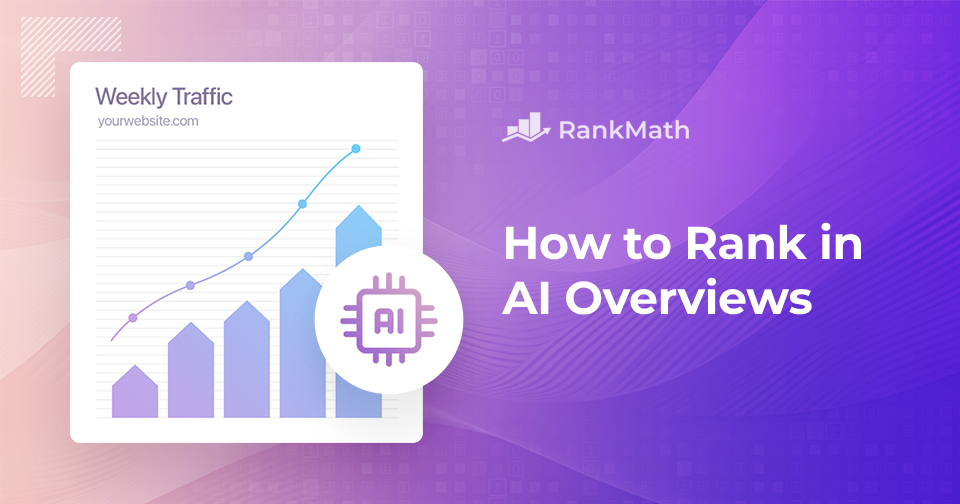Google’s AI Overviews are changing the way search results look and work. Instead of just listing links, Google shows quick AI-generated summaries at the top of some searches. These overviews give users instant answers, often pulling info from multiple websites.
So, why should you care? As per our research, 64% of searches include AI overviews.
If your content gets featured in an AI Overview, it can bring in more visibility, clicks, and traffic, even if you’re not ranking #1 in traditional search results.
In this post, we’ll show you how to optimize your content to rank in AI Overviews.
Table Of Contents
- What are AI Overviews?
- Why Ranking in AI Overviews Matters
-
How to Optimize Your Content to Rank in AI Overviews
- Prioritize High-Quality, Authoritative Content
- Structure Your Content for Clarity
- Improve Your SERP Rankings with On-Page Optimization
- Directly Answer User Intent
- Write in Natural Language
- Build Authority and Trust Signals
- Include Updated, Factual Information
- Improve Technical SEO for Better Crawlability
- Frequently Asked Questions
- Conclusion
1 What are AI Overviews?
AI Overviews are AI-generated summaries that appear at the top of Google search results. Instead of showing just one snippet or a list of links, they provide quick, direct answers by combining insights from multiple trusted sources.
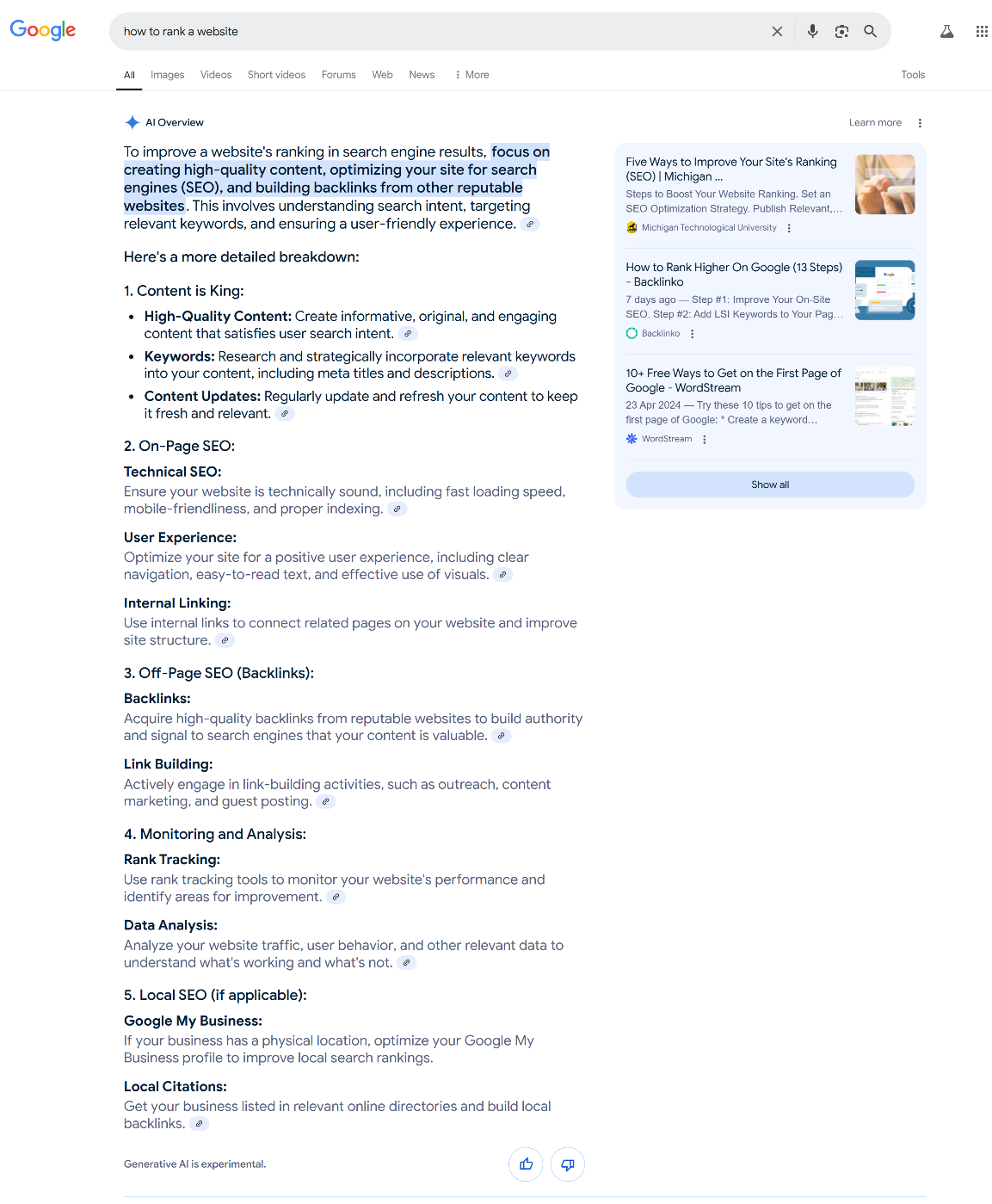
They officially launched in May 2024 as part of Google’s Search Generative Experience (SGE) and are now becoming common, especially for questions, comparisons, and research-based queries.
Unlike traditional featured snippets, which pull from a single page, AI Overviews use large language models to synthesize content from various pages. The result is a more complete summary, often with links to the original sources for further reading.
They tend to show up for informational searches (about 99.2% of the time) but also appear for planning and product-related queries.
What makes AI Overviews different is how they prioritize relevance and context over just keyword usage. That means even smaller sites can be featured, as long as the content is helpful, accurate, and trustworthy.
While they’re generally reliable, they’re not flawless. A 2022 study showed that featured snippets had a 12.5% inaccuracy rate, and AI Overviews—built on similar principles—can also struggle when source material is shaky.
Google continues to refine this feature, and recently, they’ve started linking phrases within overviews to their search results to provide more depth.
2 Why Ranking in AI Overviews Matters
Let’s be honest—landing a spot in an AI Overview is a visibility goldmine.
As of early 2025, these summaries appear in over 42% of search results and almost always sit above the organic listings and ads. That makes them the first thing users see, and often, the only thing they interact with.
But it’s not just about traffic. Getting featured tells users (and Google) that your content is credible, helpful, and worth paying attention to. Even if users don’t click right away, they’re seeing your name, your brand, and your voice.
Here’s what makes it valuable:
- High visibility, even without a top-10 ranking: AI Overviews don’t just favor the top organic results. They pull from trusted content that matches intent, giving smaller, well-optimized sites a chance to compete.
- Qualified, high-intent traffic: When people do click, they’re already interested. These aren’t random visits; they’re informed and likely to convert.
- Boosts authority and trust: Being featured aligns with Google’s E-E-A-T principles. And once you’re seen as trustworthy, users (and search engines) start to treat your content differently.
- It’s the future of search: With Google aiming to reach over 1 billion users through AI Overviews, optimizing for them is a long-term play, not a passing trend.
Based on what we’ve discussed— yes, AI Overviews absolutely impact SEO. They shape how your content is discovered, trusted, and acted on. If you want to stay visible and competitive, this is where your SEO strategy needs to be.
With that in mind, let’s dig into how you can actually optimize your content to get featured.
3 How to Optimize Your Content to Rank in AI Overviews
The truth is, there’s no secret formula to ranking in Google’s AI Overviews. Google has made it clear: just follow their regular Search guidelines — especially the ones laid out in Google Search Essentials.
Still, there are smart ways to increase your chances. Here’s where to focus:
3.1 Prioritize High-Quality, Authoritative Content
This is the foundation. If your content isn’t genuinely helpful, trustworthy, and written with care, nothing else you do will matter.
Google looks for signals of E-E-A-T: Experience, Expertise, Authoritativeness, and Trustworthiness. When your content checks those boxes, it’s much more likely to be picked for AI Overviews.
Start by understanding what your audience actually wants. Don’t just guess—verify it.
One quick way is to check your Google Search Console. Look under Performance and review the queries where your pages are already ranking, especially those around position 10 or lower. Those are the opportunities. Update those pages with clearer answers, fresher data, and stronger takeaways.
You can also use AnswerThePublic. Its WHEELS tab visually maps out common questions around a topic, helping you spot patterns and create content that better matches real search intent.
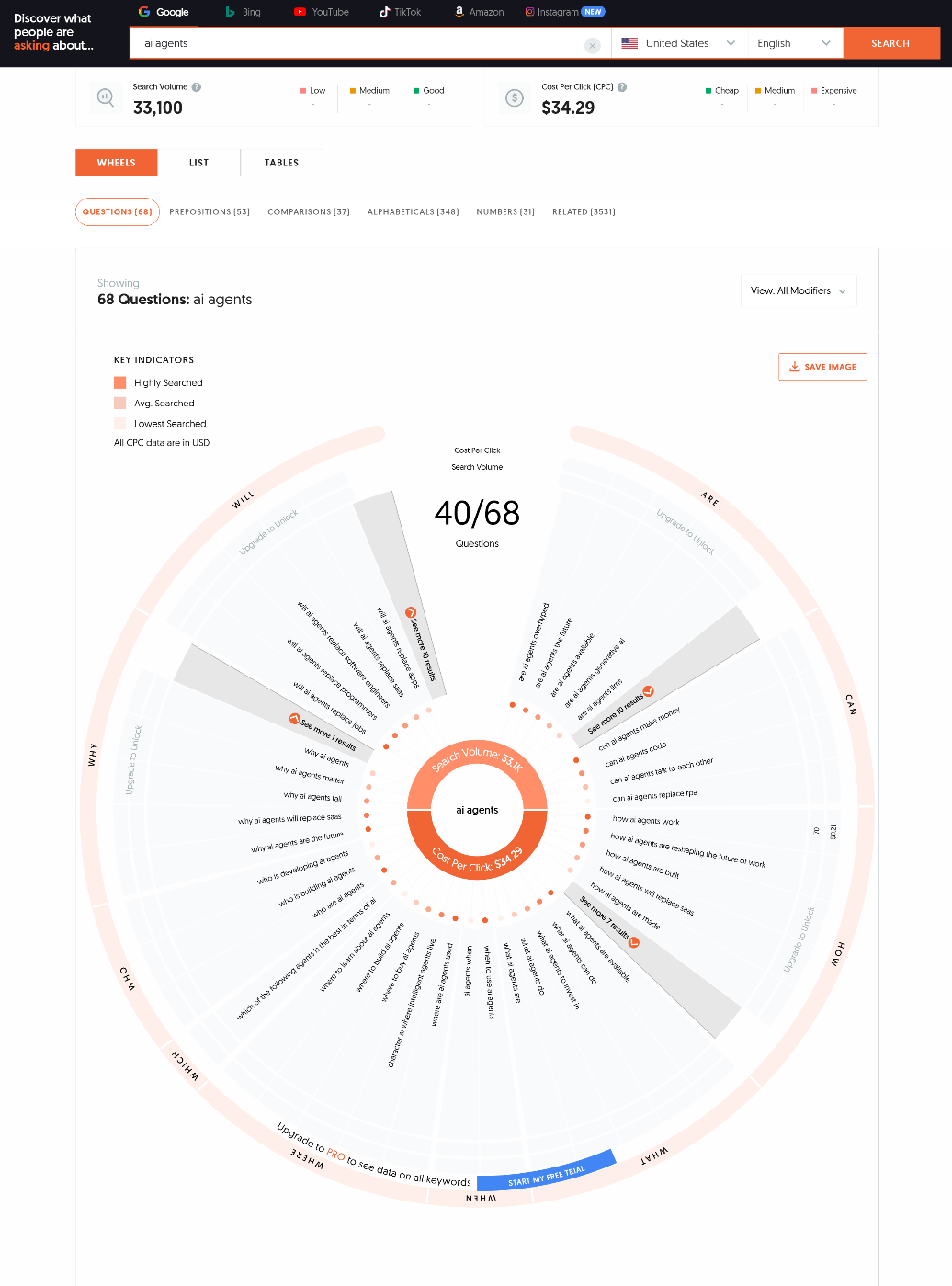
If you’re covering sensitive niches like finance or health (YMYL), trust becomes even more critical. Be transparent, cite reputable sources, and showcase credibility—things like author bios and clear branding all play a role.
Action steps to apply:
- Write people-first, intent-driven content.
- Create original work—not just rewrites of what’s already out there.
- Make your content complete and satisfying, not just long.
- Use visuals like charts or infographics to explain complex ideas clearly.
The more your content feels like the final answer users are looking for, the more likely it is to earn Google’s trust—and a spot in AI Overviews.
3.2 Structure Your Content for Clarity
If there’s one thing both readers and Google’s AI love, it’s clarity.
The way you organize your content can make a huge difference in whether it gets picked for an AI Overview. Google needs to understand your page fast, and a clean structure helps both users and algorithms do just that.

Use clear, intent-driven headings that mirror what people are searching for. Think of H2s like “What Is X?” or “How to Do Y.” Inside each section, keep paragraphs short and easy to scan. No one wants to dig through a wall of text to find an answer.
Here’s how to structure your content for better clarity and AIO visibility:
- Use meaningful H2 and H3 headings that align with real search queries.
- Keep paragraphs short—2 to 4 lines max for easy reading.
- Break down complex points using bullet points or numbered lists.
- Lead with value. Summarize the key takeaway early in each section whenever possible.
Pro tip: Add a quick TL;DR (Too Long; Didn’t Read) summary at the start of longer sections. It helps users (and Google’s AI) grab the key info instantly, especially for how-to guides and definitions.
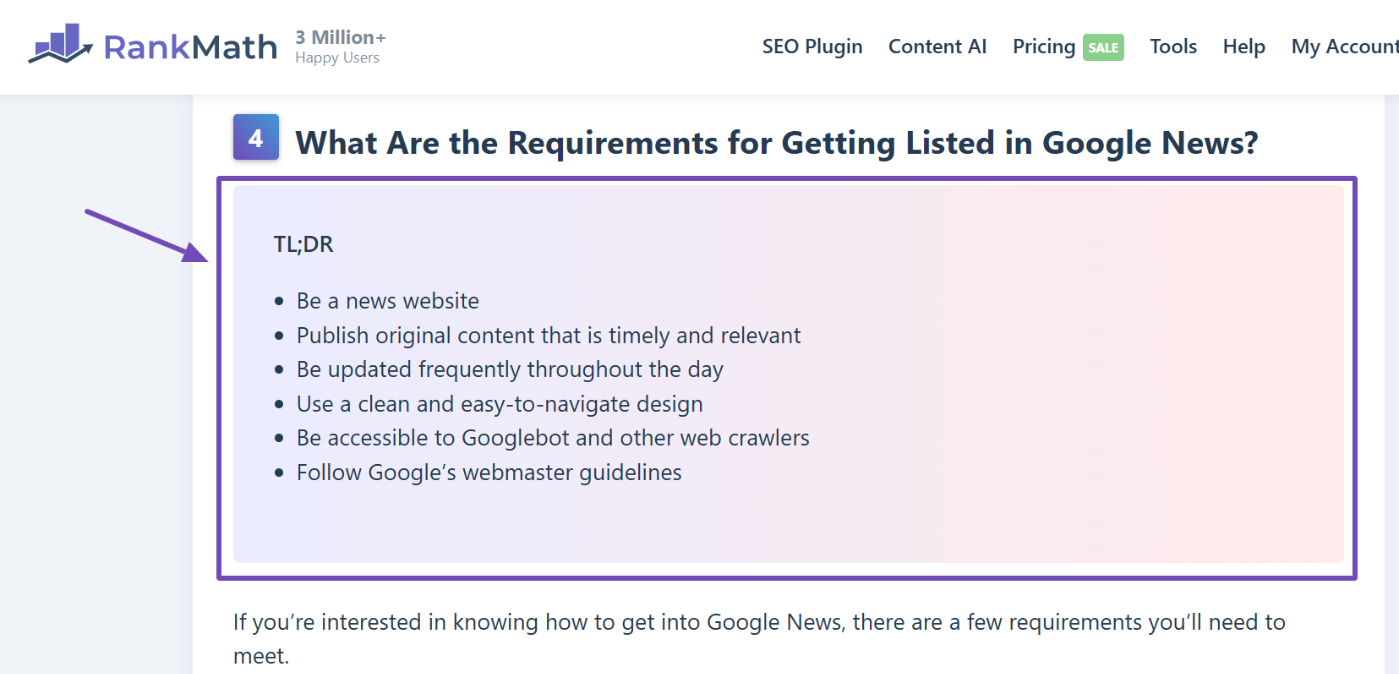
Good structure isn’t just about making your content look neat—it’s about making it easy to understand, both for your readers and for Google’s AI.
3.3 Improve Your SERP Rankings with On-Page Optimization
Even though AIOs pull from multiple sources, over 50% of featured content still comes from pages ranking in the top 10. So improving your organic SEO isn’t optional—it’s a real edge.
Focus on strong on-page optimization. It’s not about chasing algorithms—it’s about making your page easier for Google and users to trust. Use your target keyword naturally in the title, headings, and first paragraph. Keep your headings clear, your paragraphs tight, and make sure your images have proper alt text.
You can install the Rank Math SEO plugin on your WordPress site, as it makes this easier. As you write, the Rank Math Meta Box suggests optimizations for titles, keywords, image alt text, and overall content structure.
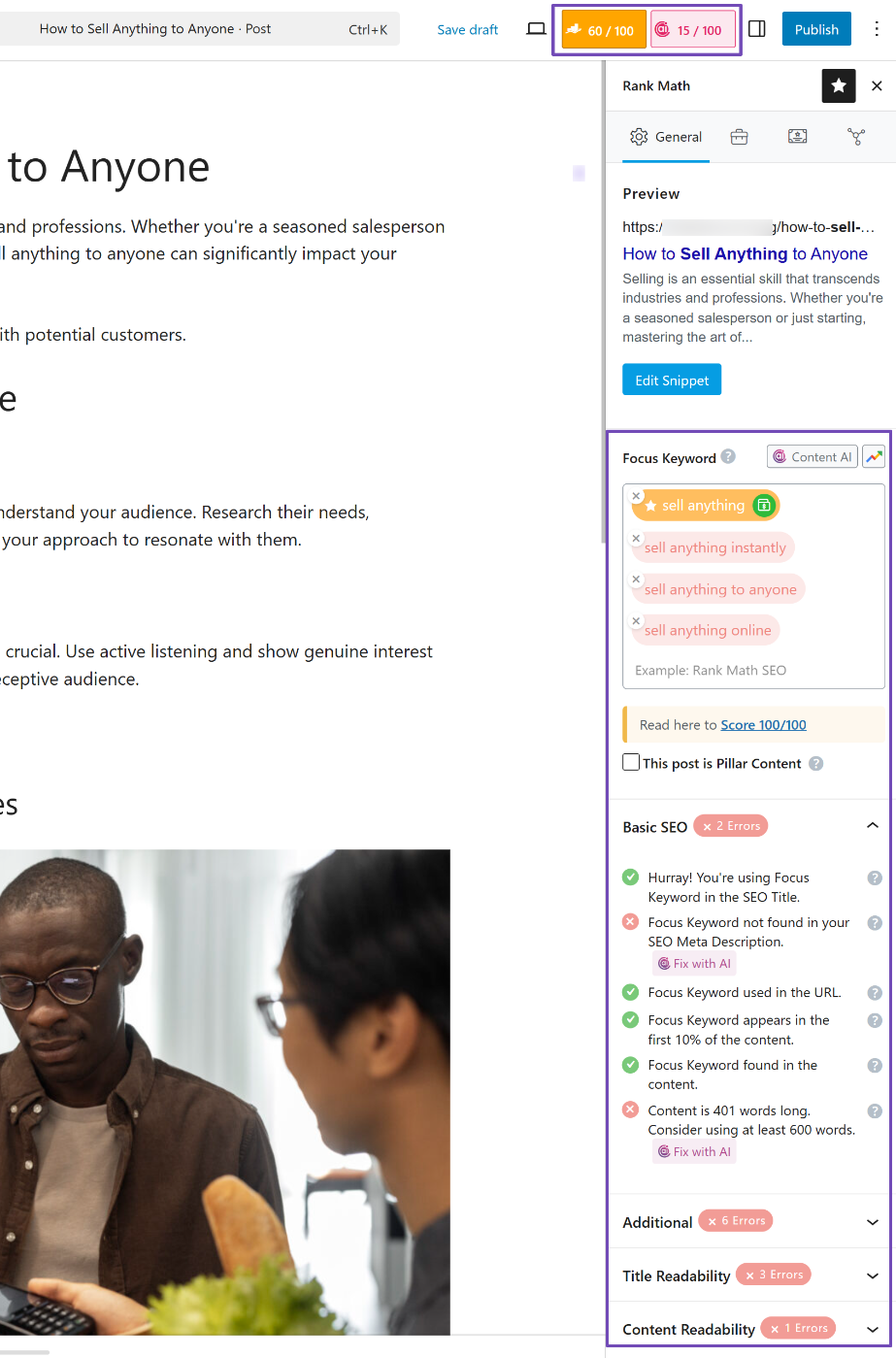
For more details on using Rank Math for SEO for content optimization, refer to this guide.
You can also use Content AI to fine-tune your article further, ensuring it balances keywords, readability, and intent before you publish. You can read more about it here.
Improving your SERP rankings not only drives organic traffic but also puts your content exactly where Google’s AI is most likely to find and feature it.
3.4 Directly Answer User Intent
To get featured in AI Overviews, your content needs to answer what users are actually asking—and do it quickly. Google’s AI is trained to spot clear, helpful responses that directly match the search intent behind a query.
Think about what the user wants. Are they looking for a definition, a process, a reason, or a quick comparison? Whatever it is, give them the answer up front. Avoid making them scroll for it.
Use question-style phrases like “how to,” “what is,” “why are,” “when did,” or “where” in your headings and naturally throughout your content. Google’s AI recognizes those signals and maps them to real search queries.
You can use our Content AI tool. Enter your keyword, check the Questions tab, and you’ll find what people are actually asking.
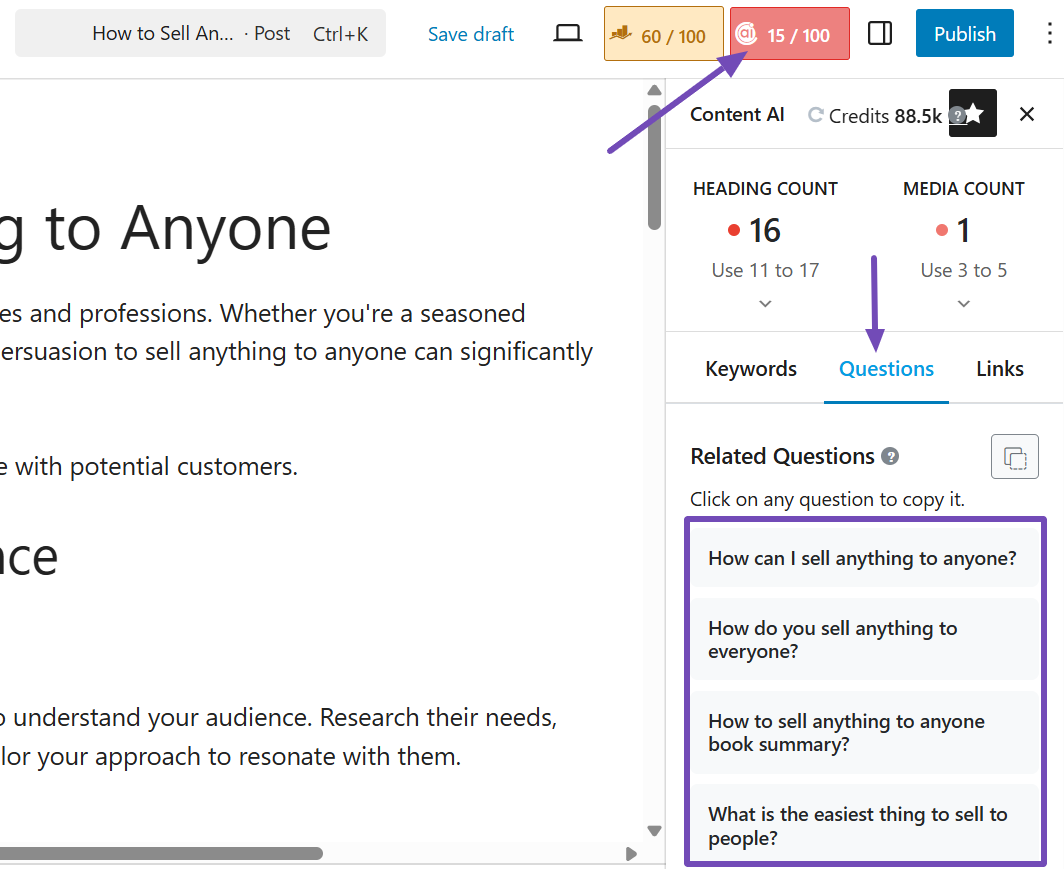
You can also scan the People Also Ask section in Google to uncover more intent-driven queries.
The goal is to be helpful, fast, and precise. When your content leads with value and mirrors what people are actually searching for, Google is more likely to feature it in an Overview.
3.5 Write in Natural Language
When it comes to ranking in AIOs, how you write matters as much as what you write. Google’s AI is trained to recognize natural, conversational language, not stiff, overly formal text.
Instead of trying to sound impressive or overly technical, write like you’re explaining something to a curious friend. Keep your sentences clear and direct. If a sentence feels complicated when you read it aloud, it probably needs to be simplified.
You can use tools like Grammarly to help catch awkward phrasing or overly complex structures as you write.

But the real goal is to make your content easy and pleasant to read.
You don’t need to repeat keywords over and over. Google’s AI understands context. Focus on clarity, helpfulness, and flow. The easier your content is to understand, the better your chances of getting pulled into an AI Overview.
3.6 Build Authority and Trust Signals
Getting featured in AI Overviews isn’t just about writing good content—it’s about being seen as a reliable voice in your space. Google’s AI looks for signals that show you know your stuff and can be trusted.
Start by building out topic clusters. When you cover something, go beyond one post—create multiple, related articles and link them together. That tells Google you’re not surface-level; you’re a resource.

Stick to your niche and go deep. You don’t have to write about everything—just dominate your lane. Whether it’s eCommerce, finance, or wellness, focus on publishing content that shows depth and consistency.
And put yourself out there. When credible sites link to you or mention your name, it boosts your authority. Guest posts, media mentions, or even sharing your content in relevant forums like Reddit can help build the kind of trust Google values.
3.7 Include Updated, Factual Information
Fresh, accurate information plays a significant role in whether your content gets featured in AI Overviews.
Google’s AI prioritizes content that reflects the latest data, trends, and knowledge. If your information is outdated or incorrect, your chances of being selected drop quickly. For instance, if you Google “latest AI trends in 2025,” you’ll see the most current answers in the AI Overviews.
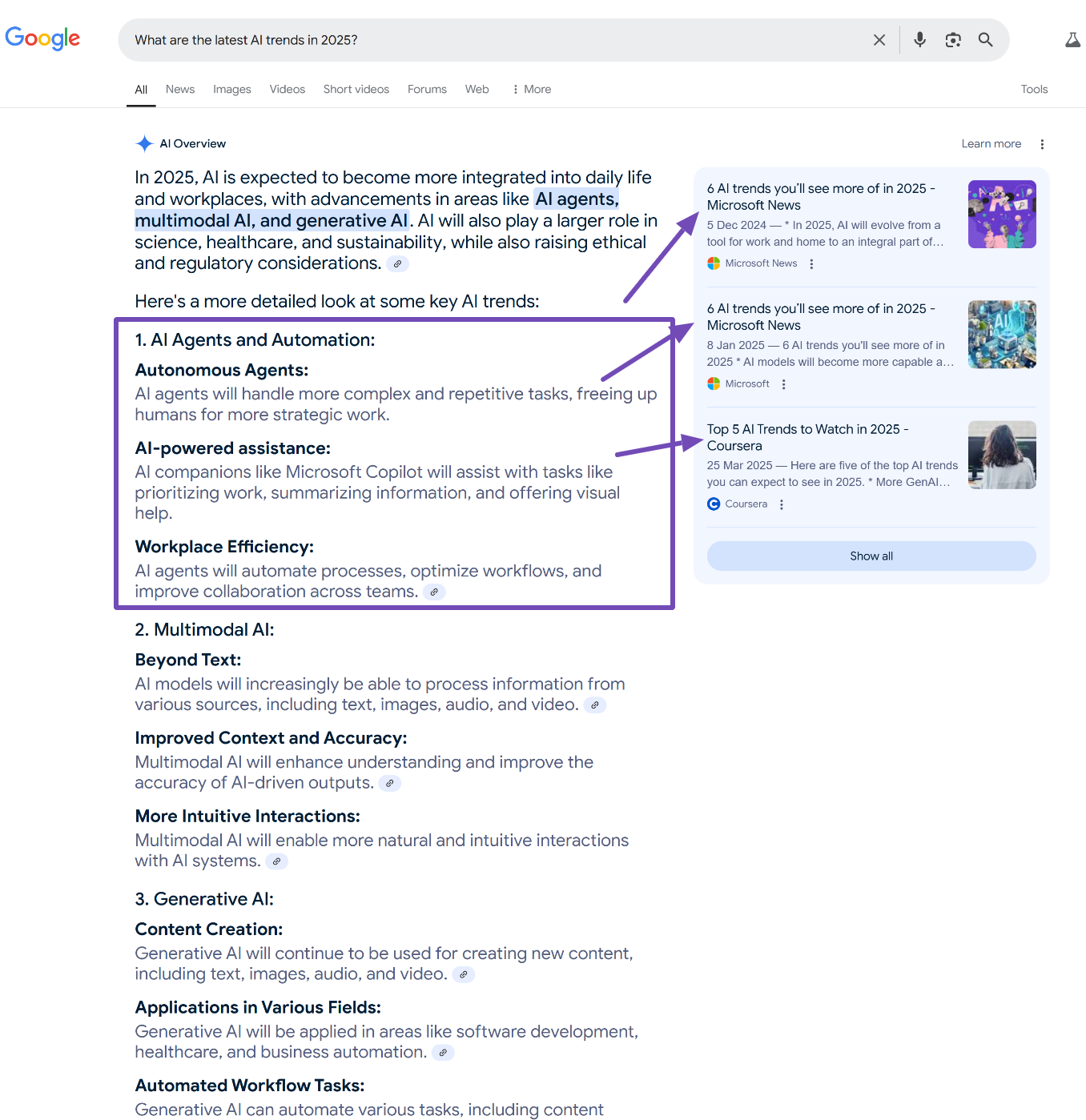
Make it a habit to revisit and update your articles regularly. Add recent statistics, newer examples, and timely references, especially in fast-moving industries like tech, finance, health, or marketing. Even a few small updates can signal to Google that your content is still relevant and trustworthy.
Always double-check your facts before publishing and link to credible, up-to-date sources wherever possible. When users and Google’s AI see that your information is current, it builds confidence in the quality of your page.
3.8 Improve Technical SEO for Better Crawlability
Having great content is one thing, but Google’s AI also needs to find and understand it. Technical SEO is what makes that happen. Here’s how to make sure your site is optimized for AI Overviews:
- Use Structured Data (Schema): Schema helps Google know exactly what your content is about. If you have FAQs, how-tos, or product info, structured data tells search engines what’s what. Rank Math makes this easy—and you can test if it’s working using Google’s Rich Results Testing Tool.
- Make Your Site Fast and Mobile-Friendly: AI Overviews show up on all kinds of devices, so your site needs to be lightning-fast and fully responsive. Google doesn’t want to send users to slow, clunky pages.
- Ensure Crawlability: Use clean, readable URLs and solid internal linking. Submit your sitemap to Google Search Console and fix issues like blocked pages or duplicates. If Google can’t crawl it, it can’t use it.
- Focus on User Experience: A secure (HTTPS), easy-to-navigate site builds trust. Broken links, 404s, or too many redirects aren’t just annoying—they can prevent your content from getting pulled into AI Overviews.
4 Frequently Asked Questions
What are AI Overviews in Google Search?
AI Overviews are short summaries created by Google’s AI that appear at the top of search results. They pull information from different websites to give you a quick answer without needing to click on multiple links.
Are AI Overviews always accurate?
While generally reliable and improving, AI Overviews are not always perfect. They can sometimes make mistakes or provide less accurate information, especially for very complex or brand-new topics, as they are based on the data they are trained on and the sources they pull from.
Do AI Overviews affect click-through rates?
Yes, they can affect click-through rates (CTR). For some queries, the quick answer might reduce clicks to individual sites. However, for others, being featured in the AI Overview can increase visibility and drive highly qualified clicks to your site. The impact can vary depending on the query and how the AI Overview is presented.
Can smaller websites rank in AI Overviews?
Yes! AI Overviews focus on providing the best, most relevant, and trustworthy information, regardless of a website’s overall authority or size. If your content directly and accurately answers the user’s question following E-E-A-T principles, it has a chance to be featured.
Is it better to focus on AI Overviews or regular search results?
Aim for both. Over 50% of sources in AI Overviews already come from the top 10 organic results, so improving your overall rankings should be your primary goal—with AI Overview visibility as an added benefit.
Why are AI Overviews not always available for different searches?
Google shows AI Overviews when its systems think they will be most helpful to the searcher. They usually appear for questions or topics that need info from different sources put together.
They might not show up for searches that are very simple factual lookups, unclear, or for topics where there isn’t enough high-quality, trustworthy information available online (sometimes called “data voids”). Google also has strong rules in place for sensitive topics like news or health, which can limit AI Overviews there. Google is also always testing and changing when they appear.
How can I prevent my content from appearing in AI Overviews?
The most reliable way to prevent your content from appearing in Google’s AI Overviews (and other generative search features) is to use the nosnippet meta tag on your page. This tag tells Google not to show snippets or summaries for your page in search results, which includes AI Overviews.
5 Conclusion
As AI Overviews become a more prominent feature in search results, adapting your SEO strategy is no longer optional—it’s essential.
By focusing on clear, concise content, using structured data, answering questions directly, and demonstrating topical authority, you significantly increase your chances of being featured.
Remember, AI systems prioritize helpful, well-organized information that aligns with user intent.
Keep monitoring how your content appears, stay updated with evolving guidelines, and continue refining your approach. With the right tactics, you won’t just show up in AI Overviews—you’ll stand out.
If you like this post, let us know by Tweeting @rankmathseo.
